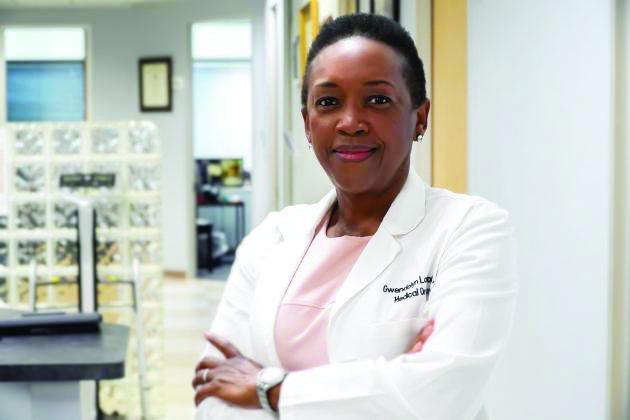Her mother worked in the cotton fields, and her father never learned to read or write; but still, the couple that came from modest means instilled in their children a value for education that catapulted their youngest daughter to the upper echelons of learning and esteem.
Dr. Gwendoyln Lavalais, now a veteran in the field of medicine who sits at the helm of care for the Julie Rogers “Gift of Life” Program in Beaumont, said the small Louisiana “town” she grew up in was a far cry from the bustling metropolitan area of Southeast Texas.
“There was maybe 300 people – total,” Lavalais said of hometown Goudeau, Louisiana. “We didn’t even have a school there. We had to go a place that was a bigger town – Bunkie.
“It’s not well-traveled.”
Marion Lavalais Sr. and Alverter Pitre, the future doctor’s parents, harvested the cotton fields where the family lived on the periphery. By 1959, sharecropping wasn’t as common as it had been previously, and the introduction of modernized cotton picking had already begun to change the family’s business.
“I was around when the cotton gins and combines were put into use,” Lavalais recalled. “Before that, it was my mom and dad out in the field – and my siblings.”
Refuse from the nearby cotton-processing site would hang over the Lavalais family home.
“All the dust would rise like a cloud,” Lavalais said. “Mom had to board the windows on that side.”
Lavalais would spend a lot of time in the boarded-up home; at 8-years-old, she was struck with a sudden illness just as she was about to enter the third grade.
“I did not walk for about a year,” she said, and was in constant transition between home and a hospital bed.
Doctors never found out what caused the lingering medical emergency, but the exposure to professionals in the field of medicine left a lasting mark on the then-infirmed Lavalais.
“At that time, they would send teachers to the hospital or home,” she said. “I really did like the doctors that took care of me at the hospital. They were probably residents, but that didn’t matter.”
“Dr. Sloan,” still an affectionately recollected figure from Lavalais’ past, would feed the young girl healthy menu items that she would turn her nose up at.
“To this day, I still eat liver,” she said. “What a kind gesture that was. It was priceless. That was very influential for me.”
Out of the hospital and back in school, Lavalais first attended an integrated school campus, Evergreen Elementary School, in the sixth grade.
“At that time, it was elementary and high school,” she said, adding that her graduating class at Cottonfort High School totaled a whopping 57.
Lavalais got the most out of the education offered to her; there was no other option at the insistence of her parents. In addition to cotton, Lavalais’ father also harvested handy whipping belts to provide school officials just in case any Lavalais offspring failed take their education seriously. Dad was too kind-natured to administer corporal punishment himself, however.
“I did not want to deal with that,” Lavalais said, offering up a vivid description of the tool of choice utilized to urge children to take their education seriously at school. “I learned to comply pretty quickly.
“They couldn’t help me with my schoolwork, but they knew the value of education.
Don’t come home with bad grades.”
Lavalais’ mother, who received some primary school education through the eighth grade, had dreamed of being a medical professional. Alverter Pitre never got the chance to make her dream come true.
“My mother … worked in the fields until I was in college, and then she began housekeeping,” Lavalais said. “She always wanted to be a nurse.”
Lavalais’ first job was as a nurse’s aid in a nursing home; her father thought she should stick with that as a career. But, Lavalais had goals; she was going to get that nursing degree her mother never had the chance to pursue. Lavalais wasn’t at the top of her graduating class – but she was an honor student, and she had a year of college already under her belt that was completed during her senior year of high school. She took the foundation she was afforded, and parlayed hard work into a bonafied nursing degree from Northwestern State University in 1980.
Having attained what she set out to do, Lavalais made a career for herself for 15 years at The Medical Center in Houston. Watching doctoral residents in training got Lavalais to thinking, though, “I can do that.”
Doubt threatened to curb aspiration.
“I always wanted to do that, to be a doctor,” Lavalais said. “But, growing up in the area where you didn’t see it, I didn’t know if I could do it.”
Setting aside her fear of failure, Lavalais set her sights on medical school, and graduated with her doctorate in 1999. After completing residency and medical oncology fellowship in Temple, Texas, Lavalais began administering medical care at a Veterans Administration hospital in town. Looking for an oncology position, Lavalais cast her sights on Southeast Texas, where oncology professionals were in abundance. In 2005, Lavalais moved to join the Julie and Ben Rogers Cancer Institute and, in 2006, Lavalais was announced as the medical director at the Dauphin Women’s Center in Beaumont.
In 2012, Lavalais retired to be a stay-at-home mom. Her first child came when Lavalais was still in medical school, and missed moments from her baby’s childhood prompted her to hang up her stethoscope after she and her then-husband adopted two children from state custody.
“I was home for several years,” Lavalais said, adding that she still stayed busy with passion projects, such as those she participated in as a volunteer for the Gift of Life.
As 2020 – and the global COVID-19 pandemic – took hold, and medical professionals were exiting in droves or sticking with skeleton crews to attend to the masses of sick patients multiplying daily, Lavalais ran right back into the fray. In 2020, Lavalais accepted a position as the medical director for Harbor Hospice; and, in 2022, Lavalais returned to a regular position at the Gift of Life as the organization’s medical director.
“The rest of the world was quitting – and I was going back to work,” Lavalais said. According to her, aside from spending time with her eldest daughter and the two high schoolers she loves dearly, there’s no place she’d rather be than with someone who needs her during their time of medical crisis.
“I love practicing medicine,” Lavalais shared. A lot of Lavalais’ patients are at the end of their life here on this earth – and she takes great pride in helping those patients transition in a manner that allows them to pass with dignity and hope. “Of course, it’s sad; but, the most important thing is how they go. It is such a privilege to be there during that time – to help ease suffering, to share suffering, to promote hope that’s different for different people as they face what comes next.”
In addition to sharing end of life, Lavalais also gets to share a new lease on life with men and women served at the Gift of Life. Lavalais has seen her share of cancer diagnoses in her own family – her mother had breast cancer, her sister had breast cancer, her father had multiple myomas, and both brothers have been diagnosed with prostate cancer.
“We are exceptionally grateful for the lasting and positive impact Dr. Lavalais will make on our program in this new leadership role,” Gift of Life Founder and Chair Regina Rogers said when welcoming Lavalais as medical director in 2022. “Her extensive knowledge, complemented by years of experience, makes her well-positioned to direct our growth as we move closer towards our shared vision of a healthier, more vibrant community. With the guidance of Dr. Lavalais, our clients will receive the highest level of compassionate care and understanding of their unique circumstances.”
With a focus on cancer screening and prevention, palliative care, outreach and promotions, Lavalais continues steadily working towards the shared goals of the nonprofit and its supporters. In 2022 alone, the Gift of Life program provided 1,611 screening mammograms, 267 diagnostic mammograms, 339 ultrasounds, 23 biopsies, 436 prostate exams, and had 11 clients diagnosed with breast cancer.
“I’ll continue to do this as long as I can,” Lavalais said. “This is just the place that I belong. When you find the fit where you belong, it’s not at all difficult to do.”
— Jennifer Johnson




